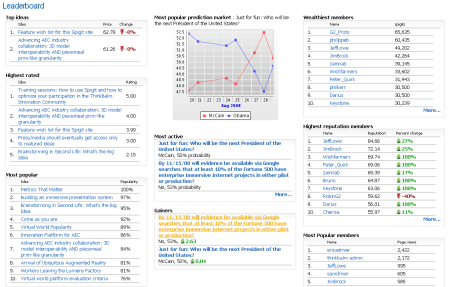I recently assisted ThinkBalm with their experiment in immersively displaying their recent business value of immersive technology study. They wanted a “tour” experience structure, requiring the displays to be “stations” along a path that participants traveled. It was quite a challenge (and a ton of creative fun) developing stations that clearly, quickly, and interactively conveyed the core message of the result topic, while also attempting to maintain a thematic visual and conceptual strain throughout. Here are a few thoughts & bits of learning from the experience:
Immersive displays require thinking experientially, not merely visually:
Quickly in the process of ideation and development I realized, this was not merely data visualization (as most people refer to this type of project). The builds needed to be not only visual, but also possess dimensions of position, ordering, presence, interactivity, and consideration of self in relation to others (considerations not typical when developing webinars, visualization graphs, or powerpoint summaries of results). True, participants would need to gather a large amount of the total message at a glance, so the visual was important. But, more importantly, we had to explore & answer questions to address these additional immersive dimensions. Questions such as:
- From what position (Avatar & camera angle) would participants view the display?
- Would different angles of view convey different meanings?
- How many would be experiencing at a time?
- How long do they need to remain to assimilate the message?
- What would they converse about when cooperatively interacting with the display?
- What do we want them to talk about?
- How will what they experienced before impact how they interpret and experience what follows?
Know the core messages:
For every display, it is critical to identify the core message/primary take away. For the Deploy-2-Save game, it was that businesses chose immersive tech over alternatives to reduce costs and increase engagement. Every other creative decision/possibility was guided by this prime. Ideas on shape, color, scale, position, transparency, rigidity, interactivity, automation, etc should be accepted or rejected based on whether it makes the core message easier or more difficult to understand.

With text, less = more:
A picture is worth a 1000 words. So avoid text when possible. Use constructs that convey concepts, and then use them to replace text when appropriate.
Participants, not viewers:
An experience is worth a 1000 pictures. So, in pulling reports, data, information, presentations into immersive environments, focus on what the participant will experience to insure the correct takeaway. Also, remember to consider how that experience will be impacted/changed by collaborative participation.

Use textures to make colors accessible to colorblind:
I used a lot of color throughout to differentiate, communicate, and establish thematic throughlines. During one of our first shakedown tours, one of the participants was red green colorblind, which dramatically impacted his experience. Sam (ThinkBalm) brilliantly applied a specific texture to each color of prim, allowing those participants with visual color disability to easily distinguish a “red” display element from a “green”. It’s a great practice I will continue for all future builds.
If you would like to visit the experiment yourself, go visit the ThinkBalm Data Gardens in Second Life. If you haven’t yet immersed yourself into Second Life and still want to see the results, watch the video tour.




 Posted by Jeff Lowe
Posted by Jeff Lowe 







